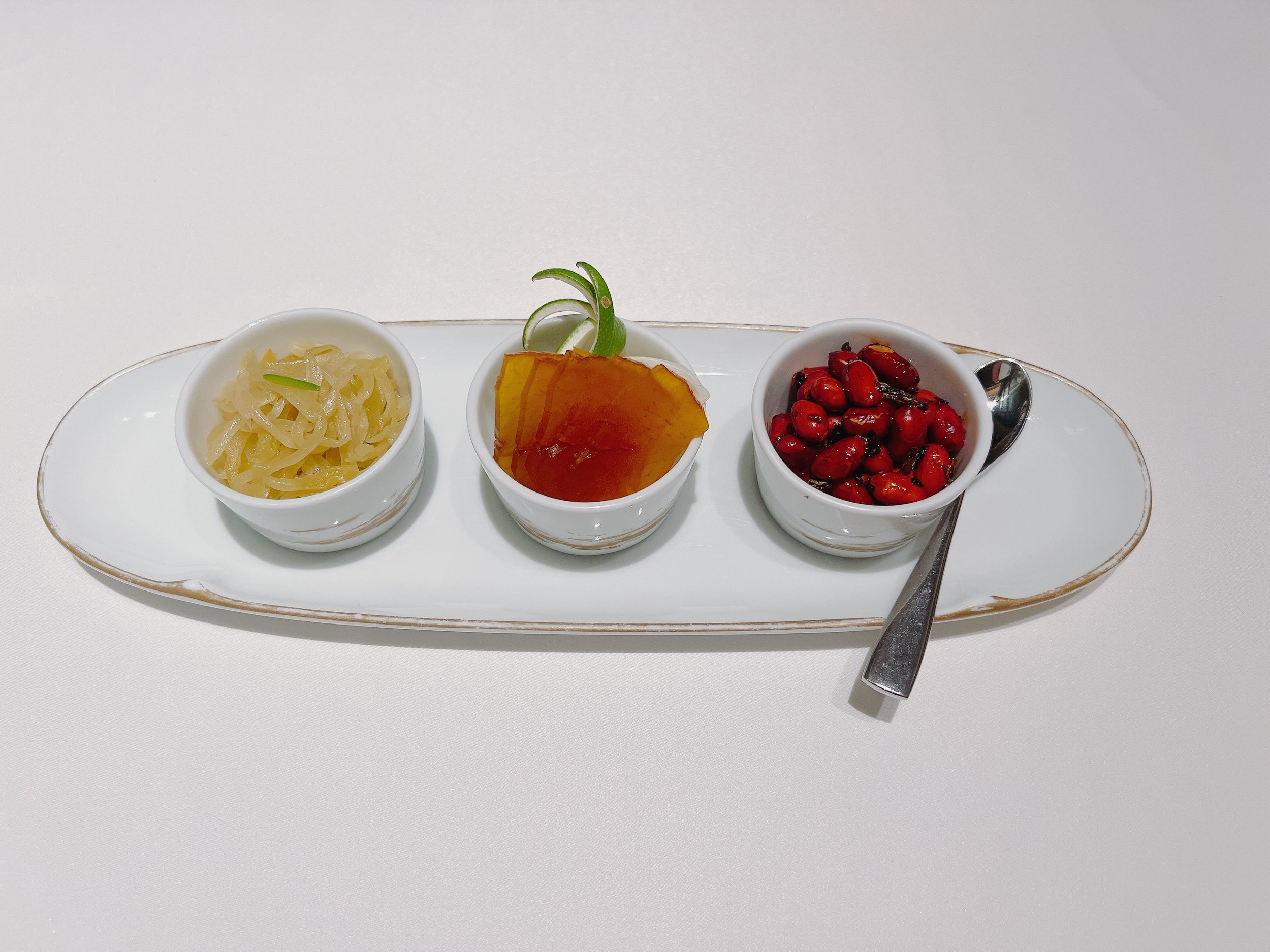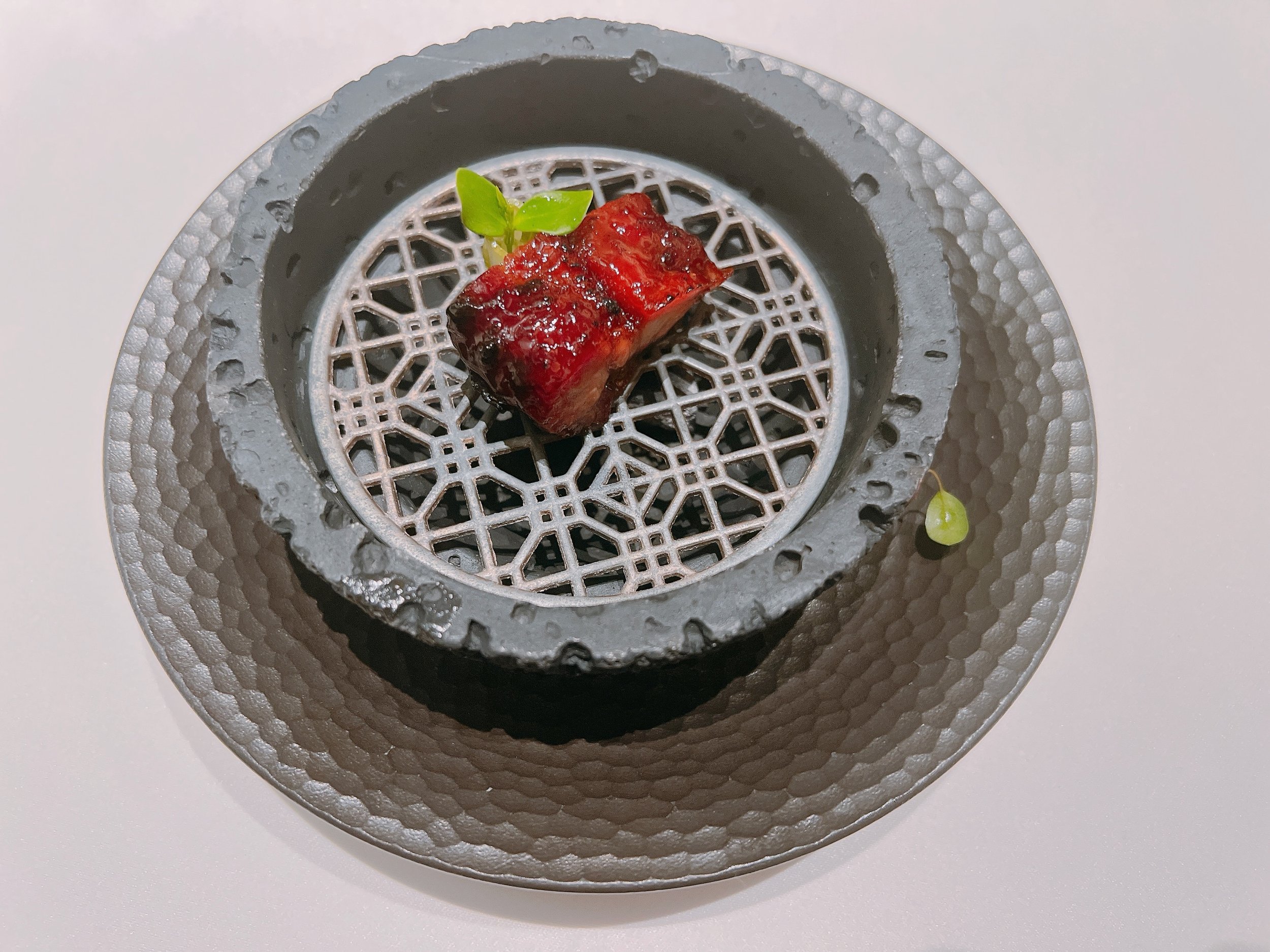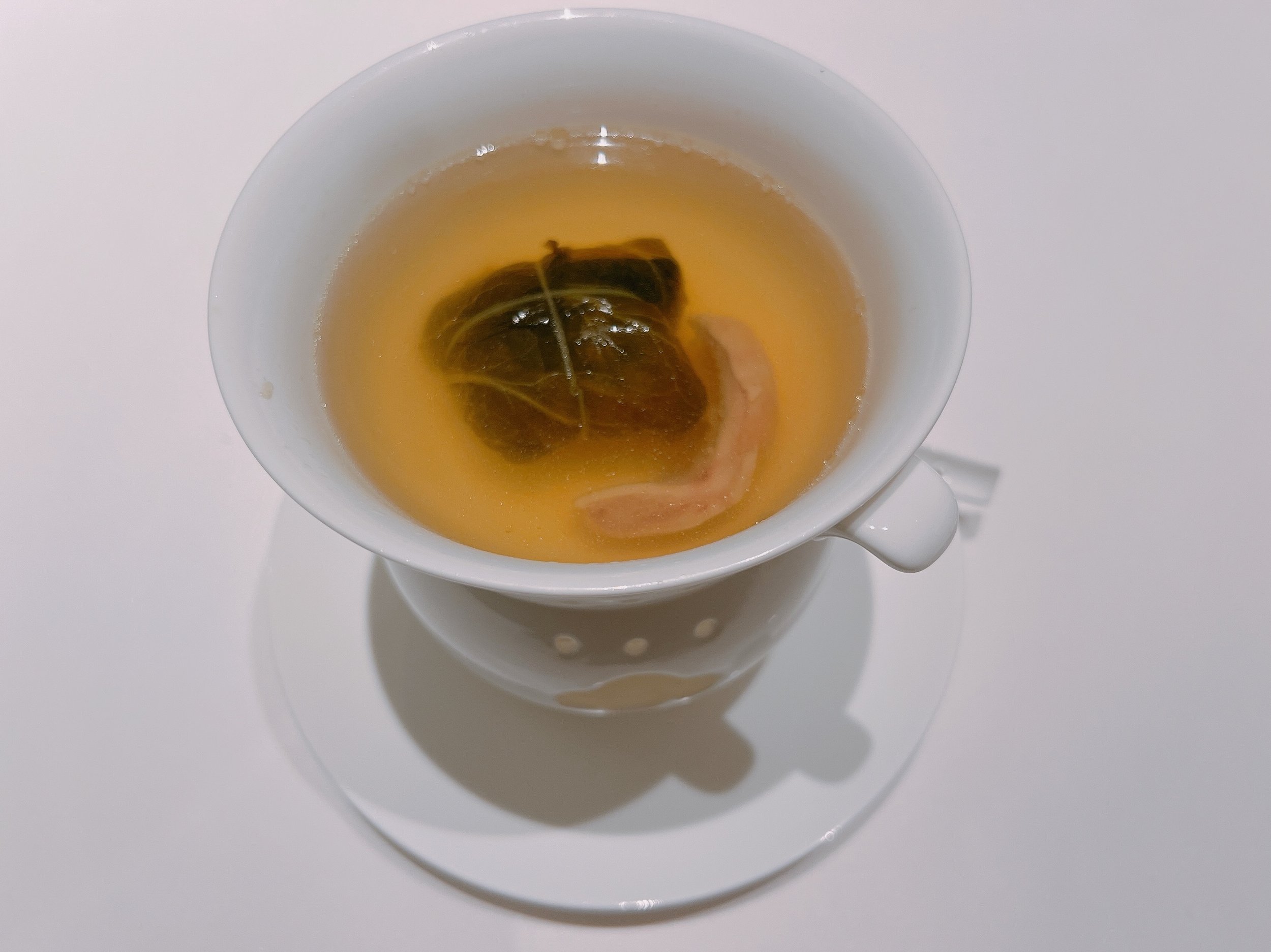Chao Shang Chao - Beijing
Rating: 16/20
Where: Beijing, China
When: Dinner for 2 on 17 November 2023
Cost per Person: Tasting menu 1888 CNY, Wine pairing 498 CNY
Accolades: 3 Michelin Stars
Why: Technically impressive renditions of regional Chaoshan cuisine
“Chao Shang Chao” is the newest member of the three-Michelin-star club in China. It is located in Beijing's Central Business District, a new-ish development full of glitzy skyscrapers and (for the time being) huge construction sites. The iconic CCTV headquarters building is just across the street. The restaurant itself is hidden on the fourth floor of a shopping mall - “hidden” since there aren't any other stores or restaurants on this floor, and most elevators don't go that far up either. Such a forlorn location would probably be the death of any restaurant relying on walk-in customers.
Similar to the other three-star restaurants in Beijing, the only way to make a reservation is by phone. But aside from that complication, it was refreshing to obtain a booking at a high-end restaurant that only required a name and an email address. Far from the prepaid, nonrefundable meals that are so common elsewhere. Apparently, no-shows are not a big problem in Beijing.
Chao Shang Chao is known for serving Chaoshan cuisine (also called Chaozhou cuisine), which comes from the eponymous region in Southern China, northeast of Hong Kong. Our tasting menu consisted almost exclusively of dishes from that region. There was also an a la carte menu, and the chef was reportedly working on a new, more upscale tasting menu after winning his third star - surely there will now be customers willing to pay more for a tasting menu than the (relatively modest) 1888 CNY. Our menu was given to us in English, and our server, the sommelier, spoke great English as well, describing dishes in great detail. A wine pairing of five glasses was available as well; each glass spanned several courses. The pours were on the conservative side (i.e. small), and the wines were fine, but not too memorable. Ordering some nice teas might be an equally good choice.
Before the start of our dinner, we were treated to the presentation of a gigantic Buddha's Hand citrus fruit. It had been marinated three times, and appeared in several of the following courses.
The first round of dishes - condiments and appetizers - arrived in quick succession. In fact, we had barely started on our first dish before the whole collection filled our table. I was a bit worried that Chao Shang Chao would serve dishes at the same alarming rate as its three-star cousins in Beijing. But thankfully, after the appetizers we went to a more relaxed pace of receiving one dish at a time.
Three condiments were served first. Chinese kale was lightly pickled “Chaoshan-style” and, unusually, looked somewhat similar to bean sprouts. Not bad 16. The aforementioned Buddha's Hand had been cut into thin slices. It was very tasty, but also quite sweet - maybe better enjoyed by itself than with other dishes 17. Finally, peanuts and pickled radishes were nice as well - crunchy and a bit sweet 15. Along with the condiments, we received a cup of warm “lemon water” - the liquid that the Buddha's Hand had been marinated in. Very sweet, and not sour at all, it was similar to a light syrup. By Western standards, this was an almost cloyingly sweet beginning to our meal, but maybe this is less unusual in China 15.
Also on the slightly sweet side was a green bean cake, made in the shape of a pear to signify longevity. (Quite the opposite of the English use of “going pear-shaped”, apparently.) The green beans had been soaked and then peeled, which explained the more yellowish rather than green color. They were then steamed and stir-fried with butter. Lightly sweet, mealy and quite buttery. Fine 15.
Hairy crab had been prepared with yellow wine, and was served in its shell, topped with crab yolk (i.e. crab eggs) and some caviar. On the side was a cup of ginger tea - in Chinese cuisine, crab is considered a “cold” dish, and ginger tea “hot”, so serving them together creates a balance. The crab meat was clearly very fresh, and quite good. The caviar was merely so-so and relatively light, but the crab yolk was very interesting - it had a very unique taste. I don't really know what to compare it to - earthy, umami? Its creaminess was a good complement to the crab meat. Overall, this was a light and refreshing start to our dinner. The ginger tea was excellent as well, very sweet thanks to the addition of brown sugar, and very spicy (17 by itself). Overall 16.
“Goose web” is the tissue on goose feet, and we received it deboned, glazed and cooked. The kitchen used young geese of at most five years. On the side was a dipping bowl filled with white vinegar and garlic. The goose feet had a bit of a BBQ flavor, probably due to the soy sauce. Chewy, but not too gelatinous, this dish was heavy on texture. Adding the vinegar had its pros and cons: it easily overpowered the taste of the goose web. I found this dish a bit hard to rate - it was not exactly my favorite, but definitely better than what I had expected based on the description 15.
The final appetizer was mackerel, prepared “frozen style” and topped with a dollop of puning bean. For mackerel, this bite actually didn’t taste very fishy. More interesting was its consistency: not raw, but seemingly cooked and a bit mealy and crumbly (but not in a bad way, surprisingly). I couldn't really taste the bean paste, though 16.
Char siu pork came next, one of the few dishes that came from Cantonese rather than Chaoshan cuisine. Pork neck meat had been smoked, and was served with freshly cured Buddha's Hand lemon on the side. The pork had a good flavor, with a bit of sweetness, savoriness, and a firm texture (due to this particular cut of meat). The piece of lemon was totally unlike the versions we had earlier, it was crunchy and not too sweet - similar to a pickle 15.
A bowl of chicken broth seasoned with black pepper contained a “package” of eel wrapped with pickles. Also in the broth was some pork tripe (described by our waiter as “the best part of the pork belly” - which is probably debatable). The dish was quite hot (temperature-wise), thanks to a tea light underneath the bowl. The eel was very good - fresh, firm and meaty, and the pickles were a nice addition, providing spice and flavor. The tripe was (merely) decent, but the broth was great - it was very flavorful and quite spicy thanks to the black pepper. A dish full of big flavors that went well together 17.
Say what you will about pigeons, but the following dish was unlike any that I had before. Pigeon was prepared two ways: its breast was seared and covered with mashed shrimp puree. And even wilder: a pigeon leg was stuffed with shark fin and Chaoshan pickles. An interesting take on surf and turf, where the two parts are integrated more tightly than usual. The shrimp/pigeon breast combination was quite light. It had a texture reminiscent of beef, and tasted more of shrimp than of pigeon. The leg was eaten without utensils; we were provided with plastic gloves to avoid a (presumably modest) mess. Its skin was very crunchy, surrounding very tender pigeon meat and a somewhat fatty shark fin. Not a light dish by any means, and impressive in its execution. Getting the outside so crispy without overcooking the meat on the inside is quite a technical achievement. My dining companion loved this dish, and thought it was better than the Peking duck that we had had the previous night, which had already been quite good. I was a bit more on the fence, the fattiness of the shark fin was a bit too much for me 15.
Interestingly, this was also the last meat course of our dinner - an inversion of what one would see in Western cuisine. So, fittingly, we received a palate cleanser: a green olive sorbet with oolong tea. Apparently, Chaoshan cuisine prefers the tannins of tea, as opposed to acidity, to cut through fat. The sorbet was covered with a hard ice shell, which made it a bit tough to eat, and it tasted more lemony than olivey to me. Fine; it accomplished its mission 14.
Steamed stone fish from the southern Yangtze river was served over tofu mixed with pork, some pickles and a preserved radish sauce. The fish was very good, fresh and only lightly steamed leaving it with some bite. I also liked the tofu and pickles - simple but tasty 17. My dining companion, a prolific home cook of Chinese food, had a slightly different take. Apparently this dish is known colloquially as (roughly) “elders and young people peaceful”, i.e. something that makes everyone at the dining table happy, including picky toddlers and/or elders. So while it was well prepared, it was also a dish quite commonly done at home, i.e. nothing too special in her mind.
A whole conch had been cooked in its shell with Chinese liquor, garlic and ginger. It was served sliced and came with two sauces, one made of shrimp, the other one (presumably) a slightly condensed version of the conch's cooking juices. Black pepper made the conch somewhat spicy, and the shrimp sauce was very salty. But the most notable aspect of this dish was the conch's chewiness. Eating it was actual work: one of those dishes were one expends more calories consuming it than the food itself provides. Even though the inner parts of the conch were a bit softer, this dish was a chore to eat - and the conch was quite large. While its flavor was decent (maybe 16?), that didn't quite make up for the effort involved (12 for the chewiness, if I rated texture). There were two bright spots: the pickled seaweed underneath the conch, and the refreshing sweet orange slices on the side. But they didn't quite make up for the rest of the dish 15.
The following traditional vegetable dish was also not specific to Chaoshan cuisine. It was a stir-fry of the most tender parts of Chinese kale, cooked with deep-fried pieces of tilefish. The vegetables were indeed tender, light in flavor, and done perfectly: neither over- nor under-cooked. The fish however, ouch, was very tough and difficult to eat. Possibly it was added for flavor and not meant to be eaten? (Our server didn't specify.) Pleasing, but nothing too exciting 14.
Our final savory course was a dumpling filled with coral grouper and served in a fishbone broth. The dumpling's skin was so delicate that it was hard to see and it practically disappeared when eaten. The fish was very flavorful, and some crunchy vegetables in the dumpling added great texture. More pickles underneath the dumpling and baby bok choy on its side were also nice. The broth was again very spicy thanks to an enthusiastic use of pepper (clearly a theme here). A great final dish 16.
Two complementary desserts followed. A panna cotta made from water buffalo milk was topped with purple rice, some nuts (pistachios and walnuts), and finished at the table with a taro sauce. Unlike most panna cottas, this one was served warm, which together with the rice made it seem more like rice pudding. Tasty, but not that special 14.
A pastry filled with taro and tangerine peel was also served warm. Its crust was very nice, but the taro filling was quite heavy and dense, the kind of texture that dries up your mouth. Ideally, it would have been eaten together with the panna cotta 14.
The final bites were fruit: melon, strawberries and kiwi, of a quality that was fine for a supermarket, but not necessarily for a three-star restaurant 13.
Overall: An enjoyable dinner with technically impressive execution. I enjoyed encountering a new regional Chinese cuisine with dishes that I've never had before in “normal” Chinese restaurants. But unlike Michelin, I can’t judge the meal's fidelity to its underlying cuisine. So just considering taste alone, I was more pleased rather than wowed; for me this was the weakest of the three current three-stars in Beijing 16.


















